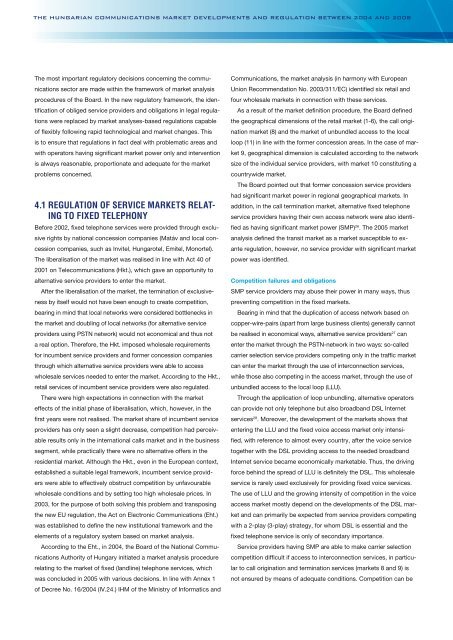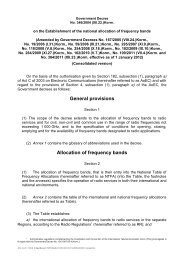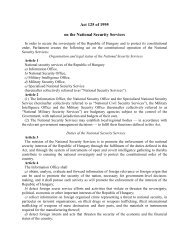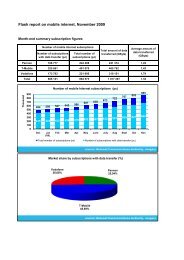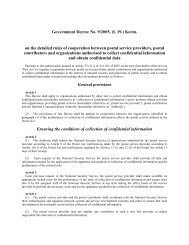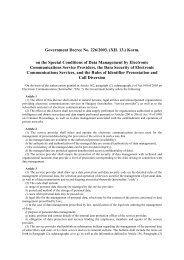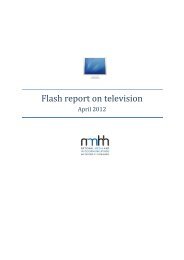The Hungarian Communications Market Developments and ...
The Hungarian Communications Market Developments and ...
The Hungarian Communications Market Developments and ...
You also want an ePaper? Increase the reach of your titles
YUMPU automatically turns print PDFs into web optimized ePapers that Google loves.
<strong>The</strong> <strong>Hungarian</strong> <strong>Communications</strong> <strong>Market</strong> <strong>Developments</strong> <strong>and</strong> Regulation between 2004 <strong>and</strong> 2008<br />
<strong>The</strong> most important regulatory decisions concerning the communications<br />
sector are made within the framework of market analysis<br />
procedures of the Board. In the new regulatory framework, the identification<br />
of obliged service providers <strong>and</strong> obligations in legal regulations<br />
were replaced by market analyses-based regulations capable<br />
of flexibly following rapid technological <strong>and</strong> market changes. This<br />
is to ensure that regulations in fact deal with problematic areas <strong>and</strong><br />
with operators having significant market power only <strong>and</strong> intervention<br />
is always reasonable, proportionate <strong>and</strong> adequate for the market<br />
problems concerned.<br />
4.1 Regulation of service markets relating<br />
to fixed telephony<br />
Before 2002, fixed telephone services were provided through exclusive<br />
rights by national concession companies (Matáv <strong>and</strong> local concession<br />
companies, such as Invitel, Hungarotel, Emitel, Monortel).<br />
<strong>The</strong> liberalisation of the market was realised in line with Act 40 of<br />
2001 on Telecommunications (Hkt.), which gave an opportunity to<br />
alternative service providers to enter the market.<br />
After the liberalisation of the market, the termination of exclusiveness<br />
by itself would not have been enough to create competition,<br />
bearing in mind that local networks were considered bottlenecks in<br />
the market <strong>and</strong> doubling of local networks (for alternative service<br />
providers using PSTN network) would not economical <strong>and</strong> thus not<br />
a real option. <strong>The</strong>refore, the Hkt. imposed wholesale requirements<br />
for incumbent service providers <strong>and</strong> former concession companies<br />
through which alternative service providers were able to access<br />
wholesale services needed to enter the market. According to the Hkt.,<br />
retail services of incumbent service providers were also regulated.<br />
<strong>The</strong>re were high expectations in connection with the market<br />
effects of the initial phase of liberalisation, which, however, in the<br />
first years were not realised. <strong>The</strong> market share of incumbent service<br />
providers has only seen a slight decrease, competition had perceivable<br />
results only in the international calls market <strong>and</strong> in the business<br />
segment, while practically there were no alternative offers in the<br />
residential market. Although the Hkt., even in the European context,<br />
established a suitable legal framework, incumbent service providers<br />
were able to effectively obstruct competition by unfavourable<br />
wholesale conditions <strong>and</strong> by setting too high wholesale prices. In<br />
2003, for the purpose of both solving this problem <strong>and</strong> transposing<br />
the new EU regulation, the Act on Electronic <strong>Communications</strong> (Eht.)<br />
was established to define the new institutional framework <strong>and</strong> the<br />
elements of a regulatory system based on market analysis.<br />
According to the Eht., in 2004, the Board of the National <strong>Communications</strong><br />
Authority of Hungary initiated a market analysis procedure<br />
relating to the market of fixed (l<strong>and</strong>line) telephone services, which<br />
was concluded in 2005 with various decisions. In line with Annex 1<br />
of Decree No. 16/2004 (IV.24.) IHM of the Ministry of Informatics <strong>and</strong><br />
<strong>Communications</strong>, the market analysis (in harmony with European<br />
Union Recommendation No. 2003/311/EC) identified six retail <strong>and</strong><br />
four wholesale markets in connection with these services.<br />
As a result of the market definition procedure, the Board defined<br />
the geographical dimensions of the retail market (1-6), the call origination<br />
market (8) <strong>and</strong> the market of unbundled access to the local<br />
loop (11) in line with the former concession areas. In the case of market<br />
9, geographical dimension is calculated according to the network<br />
size of the individual service providers, with market 10 constituting a<br />
countrywide market.<br />
<strong>The</strong> Board pointed out that former concession service providers<br />
had significant market power in regional geographical markets. In<br />
addition, in the call termination market, alternative fixed telephone<br />
service providers having their own access network were also identified<br />
as having significant market power (SMP) 26 . <strong>The</strong> 2005 market<br />
analysis defined the transit market as a market susceptible to exante<br />
regulation, however, no service provider with significant market<br />
power was identified.<br />
Competition failures <strong>and</strong> obligations<br />
SMP service providers may abuse their power in many ways, thus<br />
preventing competition in the fixed markets.<br />
Bearing in mind that the duplication of access network based on<br />
copper-wire-pairs (apart from large business clients) generally cannot<br />
be realised in economical ways, alternative service providers 27 can<br />
enter the market through the PSTN-network in two ways: so-called<br />
carrier selection service providers competing only in the traffic market<br />
can enter the market through the use of interconnection services,<br />
while those also competing in the access market, through the use of<br />
unbundled access to the local loop (LLU).<br />
Through the application of loop unbundling, alternative operators<br />
can provide not only telephone but also broadb<strong>and</strong> DSL Internet<br />
services 28 . Moreover, the development of the markets shows that<br />
entering the LLU <strong>and</strong> the fixed voice access market only intensified,<br />
with reference to almost every country, after the voice service<br />
together with the DSL providing access to the needed broadb<strong>and</strong><br />
Internet service became economically marketable. Thus, the driving<br />
force behind the spread of LLU is definitely the DSL. This wholesale<br />
service is rarely used exclusively for providing fixed voice services.<br />
<strong>The</strong> use of LLU <strong>and</strong> the growing intensity of competition in the voice<br />
access market mostly depend on the developments of the DSL market<br />
<strong>and</strong> can primarily be expected from service providers competing<br />
with a 2-play (3-play) strategy, for whom DSL is essential <strong>and</strong> the<br />
fixed telephone service is only of secondary importance.<br />
Service providers having SMP are able to make carrier selection<br />
competition difficult if access to interconnection services, in particular<br />
to call origination <strong>and</strong> termination services (markets 8 <strong>and</strong> 9) is<br />
not ensured by means of adequate conditions. Competition can be


